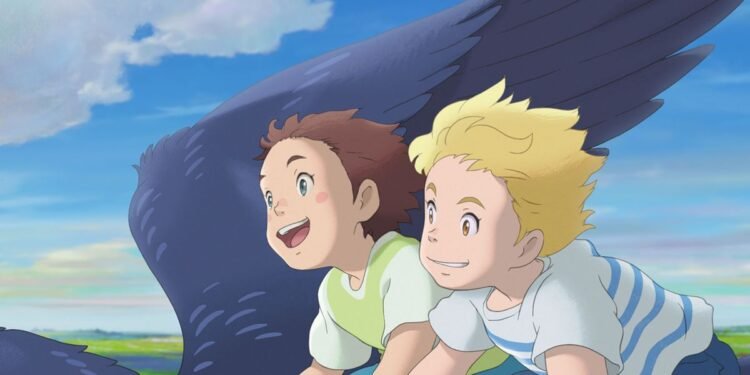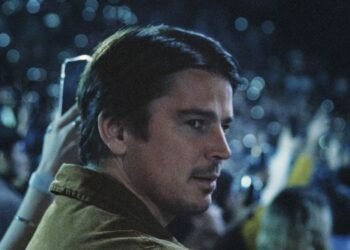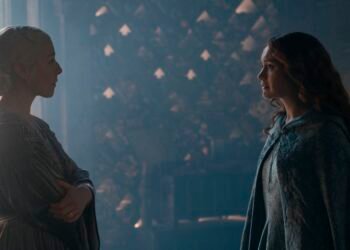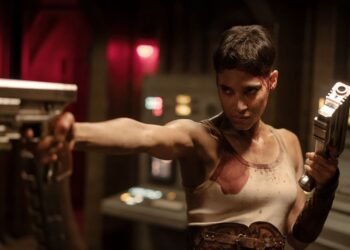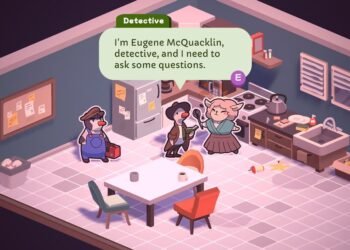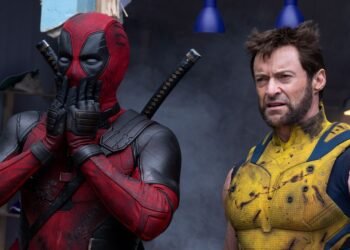This review of The Imaginary is timed to the film’s festival premiere at France’s Annecy International Animation Film Festival. The film will stream on Netflix in America starting on July 5.
When Studio Ponoc’s first anime feature, Mary and the Witch’s Flower, premiered in 2017, it came as a relief — a promise that the legacy of Japan’s famed animation powerhouse Studio Ghibli wouldn’t be entirely lost with Ghibli’s rumored plans to shut down. Founded by Ghibli veteran Yoshiaki Nishimura (producer of When Marnie Was There and The Tale of the Princess Kaguya), and taking on former Ghibli employees in an attempt to preserve their experience and skills for future animated projects, Ponoc came into the world openly billed as Ghibli’s successor. Mary and the Witch’s Flower was so clearly modeled on Ghibli designs and storytelling that the transition seemed fait accompli.
But Ghibli stayed in business, with co-founder Hayao Miyazaki laboring away on another animated feature, The Boy and the Heron, while his son Goro experimented with digital animation to make the television movie Earwig and the Witch. And Ponoc’s output has been slow over the past seven years, with no new feature films — just the charming shorts collection Modest Heroes, and some lovely promotional projects. So its new feature The Imaginary is a second round of relief for animation fans — both because the company is still in the moviemaking business, and because The Imaginary sees it just starting to edge away from outright Ghibli mimicry. (And, as a side note, because 2024 has been a terrible year for cinematic imaginary friends so far.)

Image: Studio Ponoc/Netflix
The Imaginary just debuted at France’s Annecy International Animation Film Festival, and comes to Netflix July 5 via an exclusive distribution deal. Adapted from a 2014 novel by British author A.F. Harrold, the film follows a spunky young girl named Amanda and her imaginary friend Rudger. (Not “Roger,” she and Rudger keep indignantly reminding people, but Rudger, which in Netflix’s dub and the kids’ posh British accents is pronounced pretty much the same way.) Rudger is a little blond boy who joins Amanda on all her imaginary adventures, and seems to regard her more like a playmate than a creator, though it’s notable that she occasionally treats him like a favored toy — something respected and beloved, but still capable of being banged about a bit for excitement and drama.
Amanda’s father has recently died, and while her mother, Elizabeth, has struggled to keep the family bookstore open, she’s ready to shut it down and move on to a more secure line of work. Elizabeth seems like a kind woman who’s a bit at the end of her rope, trying to deal with grief, a failing business, and a hyper kid who leaves messes behind because she has her head in the clouds, then blames them on her imaginary friend. Their dynamic feels notably like the frustrated family energy in Calvin and Hobbes: Elizabeth wants Amanda to pick up after herself and pay attention to her surroundings, while Amanda is distracted by the elaborate, adventurous worlds she’s creating. But where Hobbes’ relationship with Calvin’s mother mostly comes down to a minor frustration that she doesn’t make tuna fish sandwiches more often, Rudger has more melancholy longings. He thinks of Elizabeth as his mother, too, and wishes she could see and acknowledge him.

Image: Studio Ponoc/Netflix
There’s a lot more Calvin and Hobbes energy at play in The Imaginary: Like Bill Watterson’s comic-strip duo, Amanda and Rudger climb into a box and it suddenly becomes a vehicle flying through the air as the real world falls away. The games they play together are more real to them than anything else in the world, and their partnership is more vivid and crucial than Amanda’s other friendships.
The movie’s most exciting, most visually exalted sequences come whenever the story enters the imagination realm, where form is fleeting and fluid. People, objects, and settings all transform on a whim, and the possibilities seem limitless. Ghibli animator Yoshiyuki Momose (Spirited Away, Porco Rosso, Whisper of the Heart) directs the film with the kind of dedication to shape-shifting and symbolic shifting Hayao Miyazaki brings to his best movies. (Millennium Actress, Paprika, and Perfect Blue director Satoshi Kon made a similar fluidity of form a signature in his movies, but usually with a conscious aggression and sense of nightmare threat instead of Miyazaki’s and Momose’s expression of bouncy joy.)
But where Miyazaki movies generally avoid outright villains, The Imaginary has a particularly compelling and present threat. There are plenty of Miyazaki-style emotional stakes as well — Rudger, like other imaginary friends, is in danger of fading away if Amanda isn’t focused on him, and he gets to see firsthand what happens to “imaginaries” whose children die, grow up, or move on. But The Imaginary compounds the danger with an actual villain, who’s better discovered than described, and who brings an old-school sense of gleeful, gloating wrongdoing to the movie, alongside all its sunny explorations of children’s adventures in the worlds they create.

Image: Studio Ponoc/Netflix
The Imaginary’s animation still shows plenty of Ghibli influence, from the overstuffed, painterly rooms packed with gleamingly detailed objects to the way characters cry, with rivers of outsized, glutinous tears pumping down their faces in messy rivers. In close-ups, when experiencing big emotions, Amanda and Rudger look very much like off-brand Ghibli characters, just a touch off-model. But Ponoc’s film is edging toward its own look as well — a softer, more painterly color scheme, thinner lines and flatter colors, and character designs a little closer to Toho-Towa’s 1989 international release Little Nemo: Adventures in Slumberland than to any specific Ghibli movie.
And Ponoc’s film also feels like it’s aimed more firmly at younger viewers than most of Ghibli’s work. The screen is frequently filled with high-energy bustle, as Rudger meets an entire colony of displaced Imaginaries or the story heads inside a different kid’s imagination. But the story itself is fairly simple and straightforward, exploring feelings of pain, loss, and fear in the Pixar mode. There are a couple of authentically scary moments, but mostly, the film keeps a kid-forward outlook, where children face the perils and solve the problems adults are oblivious to, and playtime frequently takes center stage.
The Imaginary isn’t as visually or narratively rich as Mary and the Witch’s Flower, or as transcendent as Miyazaki projects like The Boy and the Heron. But it does feel like a move in the right direction for Ponoc, an effort at finding its own voice and its own footing. It may not be remembered decades from now with the same fond fervor as Ghibli’s early projects, but if Ponoc keeps experimenting and keeps branching out, it might well be remembered as the first step toward forming its own distinctive creative legacy, and stepping out from under Ghibli’s shadow. In the meantime, it’s a giddily thrilling experience for young anime fans, a movie aimed at visualizing what it feels like to daydream as a kid, to enter a world of absolute imagination where everything else falls away.
The Imaginary comes to Netflix on July 5.





























